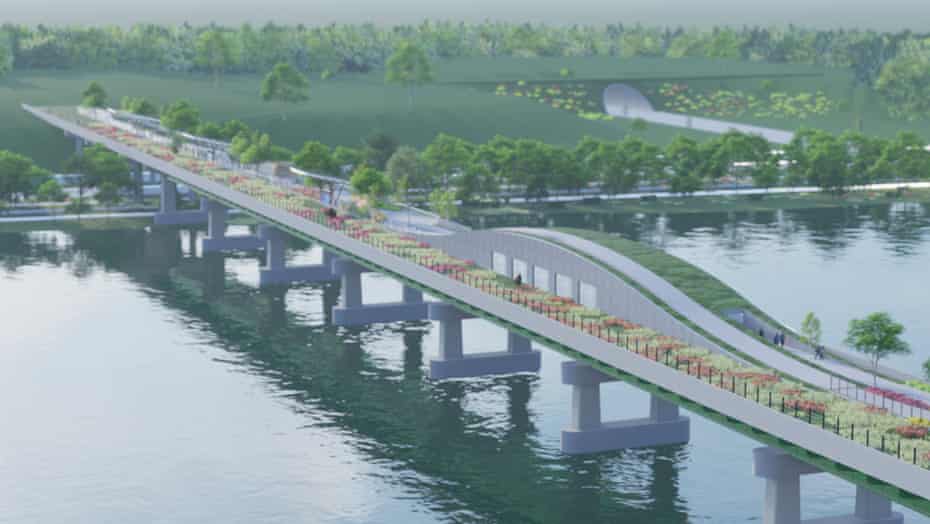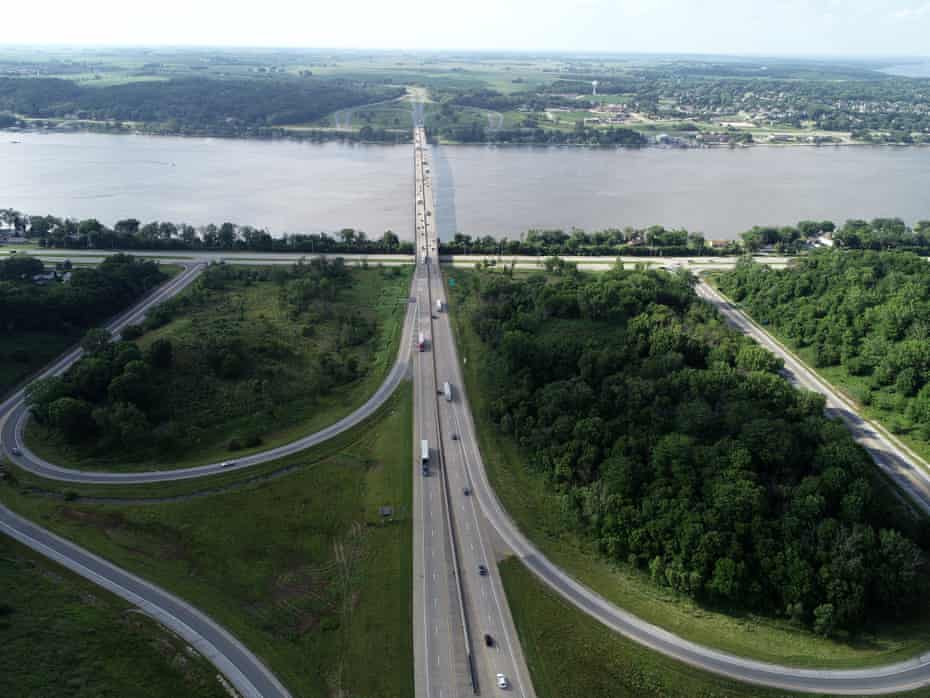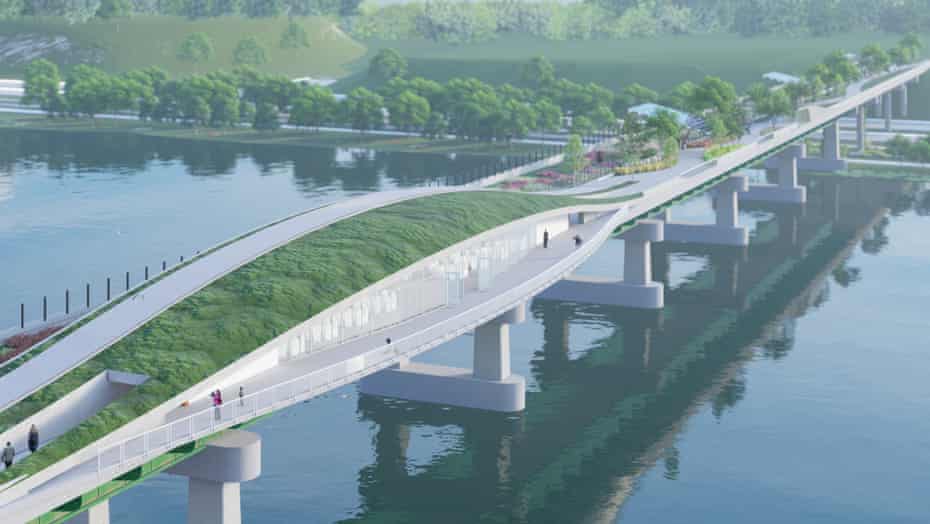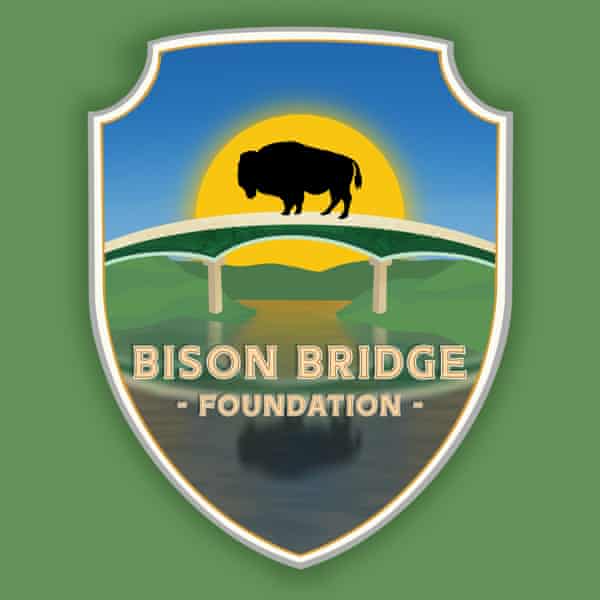Between Iowa and Illinois, spanning the only stretch of the Mississippi River that flows from east to west, sits an exhausted 55-year-old cement bridge. Each day 42,000 cars drive across the ageing structure, which is slated to be torn down and replaced.
But when Chad Pregracke looks at the bridge, he has a different vision entirely – not an old overpass to be demolished, but a home for the buffalo to roam.
The conservationist and local hero hails from the Quad Cities, a 300,000-person metropolitan area spanning two states on either side of the Mississippi River. It is named for its four cities: Bettendorf and Davenport in south-eastern Iowa and Moline and Rock Island in north-western Illinois.
Pregracke spends months every year living on barges and cleaning up refuse from the Mississippi, and he has brought his passion for the river to his latest project: converting the ailing bridge into a buffalo preserve. The idea came to him four years ago as he drove across the bridge one day, he says: “I thought, what if we made this a wildlife crossing?”
Now, his unlikely vision is being taken seriously. The departments of transportation in Iowa and Illinois are considering the proposal, which would break ground in as little as five years.

If completed, the bridge would become the longest human-made wildlife crossing in the world. The plan would see a new bridge built further down the river, where car traffic will be rerouted, and the existing bridge converted for use by humans and American bison – colloquially known as buffalo.
On one side would stand a pedestrian path and bike path, and on the other an enclosed bison paddock that would let visitors see eye to eye with the huge creatures. The herds would be free to roam between Iowa and Illinois in the grassy expanse, and the project would establish the first national park in either state.
While in many ways unique, the proposal follows a growing trend of urban renewal projects – perhaps most famously the High Line in New York City, a raised railroad converted into an elevated park. In Chicago, a raised railroad track was also converted into a park and bike trail. In Los Angeles, there have been proposals to convert part of the 101 freeway into a park.
Meanwhile, bison preserves featuring small herds have emerged in various locations across the US, including outside of Denver and in the middle of San Francisco’s Golden Gate Park.
Advocates for the Bison Bridge, as it is being called, say repurposing the structure rather than demolishing it would reduce waste, save costs, and benefit the environment. Pregracke says the project would help turn the Quad City area into a world-class destination, highlighting the Mississippi River as a feature worth traveling to, rather than a body of water to be crossed on the highway. “I mean, how could you not stop for bison?” Pregracke said.
Native American groups say bison restoration is an important means of reconnecting with the land and local history – and recognizing the interlinked atrocities committed against bison and Indigenous people.
Since 1997, the National Wildlife Federation has held a conservation agreement with an intertribal advocacy group for the return of wild bison to tribal lands and “restoring Native Americans’ cultural connection to bison”. What is now the Quad Cities was, in the early 1800s, a principal trading center for Indigenous peoples. Advocates say highlighting the area’s traditional connection with bison can call attention to that history.
The bison’s history as a ‘cornerstone species’
Buffalo were once abundant in the midwest and western United States, but they were hunted nearly to extinction.
In the mid-1800s it was estimated that 30 million to 60 million buffalo roamed the Great Plains before the US government began to systematically target them as a means to starve Indigenous Americans and drive them off their land. By the end of the 19th century, only 300 wild bison remained.

Pregracke has convened a team of experts to help bring the bridge to life, including Jason Baldes, a tribal bison coordinator for the National Wildlife Federation. A member of the Eastern Shoshone, Baldes works to restore bison to the lands they once populated and reconnect them with Indigenous peoples who revered them as a main source of food and a spiritual symbol.
“The bison was known as the life commissary for my grandmas and grandpas,” Baldes said. “It was food, clothing, shelter, and was also central to our cultural and spiritual belief systems.”
Baldes said restoring bison in the US was important both culturally and ecologically. Bison are known as a keystone species, meaning their existence benefits a number of species in their native habitats.
The stampedes of millions of bison on the Great Plains helped aerate the soil, aiding in plant growth and the dispersal of native seeds to create a varied ecosystem. The fur of the animal is ideal for insulating the nests of certain birds, and burrowing owls once relied on their dung for building their homes. Bison have a tendency to wallow, or roll around on the ground, creating small depressions that provide unique habitats for plant and animal species.
Baldes said the reintroduction of bison to tribal communities and public parks represented an opportunity to teach the broader public about that painful history and rebuild.
“We are finding ways to heal from the atrocities of the past, and buffalo restoration, and the restoration of the foundation of our cultural values and belief systems, is very important to that,” Baldes said.

Baldes said based on his experience with bison populations, the bridge would be a sufficient size for a small herd of eight to 10 animals. But the small size did not diminish the importance of the project, he said, adding that he saw it as a “very key educational tool” for the broader public. The Meskwaki nation had been contacted regarding the project but was not collaborating in an official capacity as of now, a spokeswoman said.
“Bison were destroyed as a means to eradicate Native American land holdings and inflict genocidal practices, so for our tribal communities, buffalo restoration is very important,” Baldes said. “But it’s not only important to Native American tribes, but it’s important to the American people to at least have an opportunity to learn about this history.”
Local agencies anticipate a bison boom
Daniel MacNulty, an associate professor of wildland resources at Utah State University who studies wild bison populations in Yellowstone national park, said the repurposed bridge would in fact make a feasible habitat for the animals. Bison were hardy animals that could easily adapt to new surroundings, and while the size of the park proposed would not necessarily support a large herd of bison, a small herd would serve an important purpose.

“It is certainly an out-of-the-box idea, but it provides an opportunity to conserve bison,” MacNulty said. “Any time the public is exposed to information about the ecology of bison and the Great Plains, it is a positive thing.”
Officials in the Quad City area have been supportive of the project in part because of the opportunities it could bring for tourism and growth to the area, which has had a stagnant population for more than 30 years. The project has been endorsed by the local community and economic development organization the Quad Cities Chamber and the regional tourism board Visit Quad Cities.
“We are trying everything we can do to make the Quad Cities a prosperous regional economy – and that means we need to think differently about how we attract and retain residents and businesses,” said Paul Rumler, president of the Quad Cities Chamber.
Currently, the area sees 1.6m visitors per year, generating $954m in local spending. Visit Quad Cities estimates a new national park could quadruple that number in just the first year, with sales tax bringing a “huge boost” to local hotels and restaurants.
“We would like to be able to point to this and show that this is how we do business here – we are creative, we are innovative and willing to try new concepts, and we have the perseverance to pull it off,” Rumler said. “We all need a crazy idea to latch on to.”